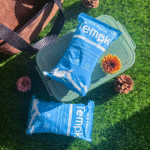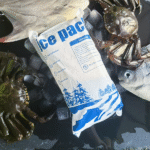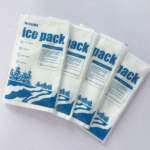الفرق بين الجليد الجاف وحزمة الثلج: التي تختار لشحنتك?
عند شحن المنتجات الحساسة لدرجة الحرارة, the choice between حزم الجليد والثلج الجاف can significantly impact your cold chain efficiency. لكل منها فوائده الفريدة, ولكن أي واحد يجب أن تستخدمه لاحتياجاتك المحددة? سيؤدي هذا الدليل إلى تحطيم الاختلافات بين حزم الجليد الجاف وحزم الثلج, مساعدتك في تحديد أفضل خيار لشحناتك.
-
How dry ice and ice packs work to maintain temperature
-
Key differences in their cooling properties
-
Best use cases for dry ice vs ice packs
-
Cost and environmental considerations
-
Safety tips when using dry ice and ice packs in shipments
How Do Dry Ice and Ice Packs Differ in Cooling?
الثلج الجاف هو CO stand الذي يتسامي في -78.5 درجة مئوية, توفير درجات حرارة متطايرة مثالية للحفاظ على المنتجات متجمدة خلال الشحنات الطويلة. عبوات الثلج, على الجانب الآخر, تحتوي على مادة تغيير الطور (بي سي إم) يبقى باردًا ضمن نطاق 0–8 درجة مئوية, making them suitable for refrigerated items but not for frozen goods.
Dry ice is ideal for long-duration shipments that require freezing, while ice packs are better for short-term cooling when refrigeration is needed.
Key Differences Between Dry Ice and Ice Packs
| طريقة التبريد | نطاق درجة الحرارة | الاستخدام المثالي | مدة التبريد |
|---|---|---|---|
| الجليد الجاف | -78.5 درجة مئوية | أغذية مجمدة, الأدوية | 24-72 ساعة |
| حزم الثلج | 0-8 درجة مئوية | البضائع المبردة, الإمدادات الطبية | 12-48 ساعة |
نصائح عملية
-
Use dry ice for frozen goods: Best for items that need to remain frozen for extended periods.
-
Use ice packs for refrigerated items: Perfect for maintaining the 2–8°C range for medical or food items for up to two days.
-
For multi-temperature shipments: Consider using both—dry ice for frozen products and ice packs for refrigerated goods.
مثال واقعي للحياة: A logistics company successfully shipped a variety of frozen and refrigerated goods by using dry ice for frozen products and ice packs for fresh produce, keeping all items at the correct temperatures for 72 ساعات.
When Should You Use Dry Ice Over Ice Packs?
Dry ice is the best option when you need sub-zero temperatures, typically for long-duration shipments or for products like أغذية مجمدة, الأدوية, أو العينات البيولوجية. The extreme cold of dry ice keeps items frozen during transport, especially in situations where refrigeration won’t suffice.
لكن, dry ice has a few downsides—it sublimates quickly, and it requires special ventilation due to the carbon dioxide it releases, making it unsuitable for certain environments or smaller shipments.
أفضل الاستخدامات للثلج الجاف
-
أغذية مجمدة: Ideal for ice cream, اللحوم المجمدة, or seafood that needs to remain frozen during long shipments.
-
الأدوية: Used for medications like vaccines or biologics that need to stay frozen throughout transit.
-
Extended Shipping: Dry ice is essential for shipments that will take more than 24 ساعات, ensuring temperature control for multiple days.
Dry Ice vs Ice Packs for Frozen Products
| نوع المنتج | فعالية الثلج الجاف | Ice Packs Effectiveness | أفضل استخدام |
|---|---|---|---|
| الأطعمة المجمدة | فعالة للغاية | غير فعالة | Dry ice for long trips |
| الأدوية | فعالة للغاية | غير فعالة | Dry ice for frozen meds |
| البيولوجيا | فعالة للغاية | غير فعالة | Dry ice for critical shipments |
When Should You Use Ice Packs Over Dry Ice?
Ice packs are perfect for maintaining refrigerated temperatures, عادة بين 0-8 درجة مئوية. They are ideal for shipments that do not need freezing but require a stable cool environment. Ice packs are commonly used for short-term transport و easy-to-handle applications.
Ice packs are easier to use than dry ice—no special ventilation is required, and they are typically more فعالة من حيث التكلفة for smaller shipments.
Best Uses for Ice Packs
-
الإمدادات الطبية: Keep items like insulin, اللقاحات, or antibiotics cool during transit.
-
طعام جديد: Use for products like fruits, خضروات, ألبان, or meats that need refrigeration but not freezing.
-
Shorter Shipping Durations: Ideal for shipments under 48 hours that don’t need freezing temperatures.
Ice Packs vs Dry Ice for Refrigerated Products
| نوع الشحنة | Ice Packs Effectiveness | فعالية الثلج الجاف | أفضل استخدام |
|---|---|---|---|
| Refrigerated Goods | فعالة للغاية | غير فعالة | Ice packs for short trips |
| الأدوية | فعالة للغاية | غير فعالة | Ice packs for refrigerated meds |
| مستحضرات التجميل | فعالة للغاية | غير فعالة | Ice packs for temperature-sensitive items |
التكلفة والاعتبارات البيئية: Dry Ice vs Ice Packs
Dry ice can be more expensive because it must be replenished frequently during long shipments. بالإضافة إلى ذلك, it is a sublimating material, meaning that it releases carbon dioxide as it evaporates, المساهمة في انبعاثات الغازات الدفيئة. Proper handling and disposal are crucial for safety and sustainability.
عبوات الثلج, على الجانب الآخر, نكون قابل لإعادة الاستخدام, making them a more صديقة للبيئة و فعالة من حيث التكلفة solution for many shipments. They don’t produce gases and can be disposed of with minimal impact on the environment.
مقارنة التكلفة: Dry Ice vs Ice Packs
| طريقة التبريد | متوسط التكلفة لكل شحنة | التأثير البيئي | أفضل استخدام |
|---|---|---|---|
| الجليد الجاف | $25– 50 دولارًا | عالي (انبعاثات CO₂) | البضائع المجمدة على المدى الطويل |
| حزم الثلج | $10– 30 دولارًا | قليل (غير سامة, قابل لإعادة الاستخدام) | البضائع المبردة قصيرة الأجل |
2025 الاتجاهات في لوجستيات سلسلة البرد: الابتكارات واللوائح
ال cold chain logistics industry is evolving with more eco-friendly cooling options, as sustainability becomes a top priority. حزم هلام و smart temperature monitoring devices are becoming more common, while dry ice technologies are being developed to reduce sublimation rates and carbon emissions.
أحدث الاتجاهات
-
Sustainable cooling solutions: More companies are adopting biodegradable ice packs and more efficient dry ice usage.
-
Smart temperature tracking: The integration of IoT-based devices to monitor temperature during transport is improving cold chain efficiency.
-
Regulation updates: Stricter rules around the use of dry ice and gel packs to ensure environmental responsibility.
نظرة السوق: The shift towards green logistics is evident, مع 28% of cold chain companies reporting a move toward sustainable packaging solutions.
الأسئلة المتداولة {#التعليمات}
س: Can I use dry ice for refrigerated products?
لا, dry ice is too cold for refrigerated products that require temperatures above –20°C. Ice packs are better for keeping goods cool but not frozen.
س: How long do ice packs last compared to dry ice?
Ice packs typically last 12–48 hours, while dry ice can last 24–72 hours depending on the shipment size and insulation.
س: جاف آمن للتعامل مع?
نعم, but it must be handled with care, using insulated gloves, and must be properly ventilated to avoid CO₂ build-up.
ملخص & الوجبات السريعة
Dry ice and ice packs are both essential for cold chain logistics, but they serve different purposes. يستخدم dry ice for frozen goods و ice packs for refrigerated products that require cooling without freezing. يعتبر يكلف, التأثير البيئي, و duration of shipment when deciding which cooling method to use.
ماذا تفعل بعد ذلك
-
Assess your shipping needs and choose the right cooling method based on your products.
-
Order dry ice or ice packs من Tempk لشحنتك القادمة.
-
شارك هذا الدليل with your logistics team to streamline your cold chain processes.
حول Tempk
Tempk specializes in high-quality temperature-controlled packaging for a variety of industries. سواء كنت تشحن الأدوية, طعام, or other sensitive products, we offer the best cooling solutions to maintain optimal temperatures.
تحتاج إلى مساعدة مع احتياجاتك في السلسلة الباردة? اتصل بنا for tailored solutions and expert advice.
























